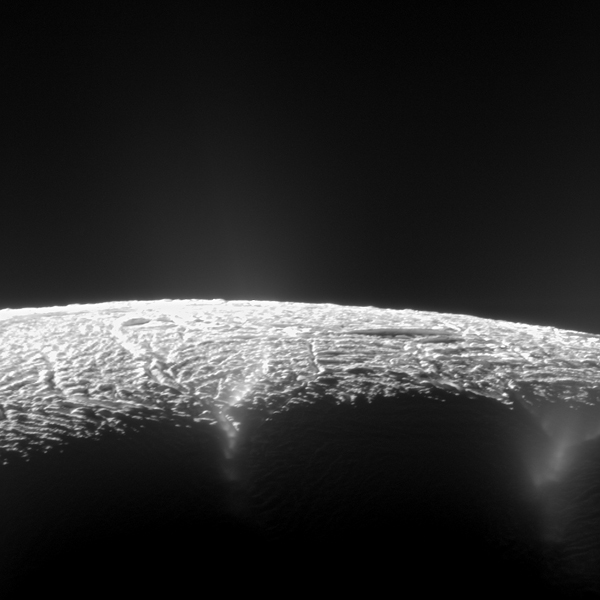
Using data from NASA’s Cassini spacecraft – which has been orbiting Saturn, weaving among its moons, since 2004 – scientists have now mapped 101 distinct geysers erupting from the surface of Enceladus, an ice world and arguably Saturn’s most fascinating moon. A seven-year survey with Cassini data shows the 101 geysers at Enceladus’ south pole, known for its prominent tiger stripe fractures. The geysers are spewing from these fractures, releasing tiny icy particles and water. Geysers were first sighted in this region nearly 10 years ago. In 2012, European scientists said Enceladus’ geysers rain water down onto Saturn. Last April, scientists announced a geophysical model for a hidden ocean inside Enceladus. They believe it is a large, possibly regional ocean, about 50 kilometers below the surface. The new work confirms that this underground sea may be feeding the geysers.
The new findings, and clues to what powers the geyser eruptions, are presented in two articles published here and here in the July 28, 2014 online edition of the Astronomical Journal.
The latest analysis confirms that it is possible for liquid water to reach from the moon’s underground sea all the way to its surface. A July 28 press release from NASA gave some history:
After the first sighting of the geysers in 2005, scientists suspected that repeated flexing of Enceladus by Saturn’s tides as the moon orbits the planet had something to do with their behavior. One suggestion included the back-and-forth rubbing of opposing walls of the fractures generating frictional heat that turned ice into geyser-forming vapor and liquid.
Alternate views held that the opening and closing of the fractures allowed water vapor from below to reach the surface.
Scientists have wanted to know which process was most important in creating the geysers. They compared the recent survey results – showing the locations of the geysers – with data collected in 2010 by Cassini’s heat-sensing instruments. In this way, they learned that individual geysers correspond to small-scale hot spots on Enceladus.
These hot spots are only a few dozen feet (tens of meters) across. The scientists say they are too small to be produced by frictional heating from tidal forces (the first suggested alternative, above), but the right size to be the result of condensation of vapor on the near-surface walls of the fractures. Carolyn Porco, leader of the Cassini imaging team from the Space Science Institute in Boulder, Colorado, and lead author of the first paper, said:
Once we had these results in hand, we knew right away heat was not causing the geysers, but vice versa. It also told us the geysers are not a near-surface phenomenon, but have much deeper roots.
The scientists then turned to a recent analysis of gravity data from Cassini. They concluded the only plausible source of the material forming the geysers is the underground sea now known to exist beneath Enceladus’ icy exterior.
They also determined that narrow pathways through Enceladus’ ice shell can remain open from the sea all the way to the surface, if filled with liquid water.
Thus they concluded that icy Enceladus’ hidden, underground sea is the dominant source of the moon’s geysers.
Read more about these studies from NASA.

Bottom line: Researchers have mapped 101 geysers on the surface of Saturn’s ice moon Enceladus. They found that the locations of the geysers correspond to hot spots on Enceladus’ surface. They have concluded that the only plausible source for the geysers is an underground sea beneath Enceladus’ icy shell.











